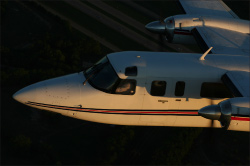The Proficient Pilot Makes
Use Of All Resources

by Hugh Davis
Over the years several words have been used to describe the proficient pilot: good stick, pro, rock solid, captain, ace of the base. Today, what might we call the proficient pilot?
During an initial or recurrent course for the Turbo Commander, there is a tier of learning that begins with a good knowledge base of the aircraft systems. These include hydraulics, electrical, pneumatics, engines and props, and other systems and how they interface. The systems are taught and reviewed not only during normal system operations but during abnormal times as well.
After a thorough systems review, we move on into the simulator to hone our flying skills and integrate time management. This includes the use of advanced avionics such as GPS, flight directors, and autopilots. To top off the coursework, there is a thorough discussion about cockpit resource management (CRM) and aeronautical decision-making (ADM).

In the 1980s the FAA required that airline companies include CRM in their training programs, and it led to the creation of whole new departments to develop the curriculum. Flight training companies such as FlightSafety International developed courses to be integrated in recurrent and initial programs. FSI also created an enrichment course for extra emphasis on CRM.
During a CRM training exercise relationships are introduced that can increase good skills, such as occurred in the DC-10 Sioux City accident, as well as scenarios that hinder cockpit performance such as the Swiss Air MD-11 accident. One of the results of this added emphasis on CRM and ADM has been a reduction in aeronautical accident rates.
CREW OR COCKPIT?
When CRM training was introduced it was called “Crew Resource Management” and it focused on aircraft operated with more then one pilot. As you may have noticed in the above paragraphs, CRM now refers to “Cockpit Resource Management,” which is descriptive of single- or dual-pilot operations. One day when I was facilitating a discussion of CRM skills a pilot asked, “Why do I need CRM? I am the only pilot on board and I make all the decisions.”
“Do you remember when John Glenn was strapped in that Mercury capsule all by himself?” I asked. “Where was his crew? There where thousands of crew members at the launch site, in the control rooms, and all the way back to Houston.” This caused the discussion to evolve into identifying some of the tools available to single pilots. We identified the air traffic controller, the flight service station, advanced avionics, the pilot operating handbook, and even the passengers.
As I reflected back on that encounter, I realized that when operating single pilot, some of my passengers have learned to listen to the radio and help me spot traffic, change the altitude reminder, hold the approach plates, and tune the radios. I have learned to listen to my passengers, and thank them as well. They are sending me flags of concern when they ask, “Is the weather okay?” “How is the turbulence?” “How are we doing on fuel?” The way we as pilots respond to those questions will determine the future dialog with our crew/passengers.
PRACTICE, PRACTICE, PRACTICE
It is extremely important that we not limit Crew or Cockpit Resource Management to only the cockpit, but use these same skills in daily activities. The more we practice CRM and ADM in our everyday life, the more they will become natural skills in the cockpit. Practice them when you are driving, making decisions with your significant other or even making decisions that affect only yourself. Getting input from others will increase your situational awareness.
So, returning to the question I posed at the beginning regarding the proficient pilot of the 21st century. Have you been able to think of some more descriptive terms for this pilot?
Remember:
A proficient pilot understands the aircraft systems.
A proficient pilot consistently hones his/her flying skills.
A proficient pilot manages time appropriately.
A proficient pilot practices CRM & ADM daily.
A proficient pilot is Me.
Hugh Davis is an Instructor at FlightSafety International’s Twin Commander pilot training center in Houston, Texas.







